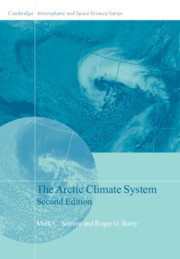Book contents
- Frontmatter
- Dedication
- Contents
- Preface
- Acknowledgments
- List of Acronyms
- List of Selected Web Sites
- 1 The Evolution of Knowledge about the Arctic and Its Climate
- 2 Physical Characteristics and Basic Climatic Features
- 3 The Basic Atmospheric and Ocean Energy Budgets
- 4 The Atmospheric Circulation
- 5 Energy Exchanges at the Surface
- 6 Precipitation, Net Precipitation, and River Discharge
- 7 Arctic Ocean–Sea Ice–Climate Interactions
- 8 Climate Regimes of the Arctic
- 9 Modeling the Arctic Climate System
- 10 Arctic Paleoclimates
- 11 The Uncertain Future
- References
- Index
- Plate Section
11 - The Uncertain Future
Published online by Cambridge University Press: 05 August 2014
- Frontmatter
- Dedication
- Contents
- Preface
- Acknowledgments
- List of Acronyms
- List of Selected Web Sites
- 1 The Evolution of Knowledge about the Arctic and Its Climate
- 2 Physical Characteristics and Basic Climatic Features
- 3 The Basic Atmospheric and Ocean Energy Budgets
- 4 The Atmospheric Circulation
- 5 Energy Exchanges at the Surface
- 6 Precipitation, Net Precipitation, and River Discharge
- 7 Arctic Ocean–Sea Ice–Climate Interactions
- 8 Climate Regimes of the Arctic
- 9 Modeling the Arctic Climate System
- 10 Arctic Paleoclimates
- 11 The Uncertain Future
- References
- Index
- Plate Section
Summary
Overview
The broad picture of Arctic change projected through the twenty-first century is a warming climate, with this warming outsized in comparison to the globe as a whole, and a continued reduction in sea ice extent in all seasons, but especially in summer and early autumn. We are also likely to see warming and thawing of permafrost, gradual replacement of tundra with shrub vegetation, a shorter snow-covered season and a modest increase in precipitation. The Greenland Ice Sheet will continue to lose mass, likely at an accelerating rate, contributing to sea level rise. This picture of the Arctic’s future, however, is muddied by unknowns. The Arctic is home to strong natural variability in climate, and it would come as no surprise if the general trend toward warming was interrupted by decadal-scale periods of little temperature change or even cooling. There are unknowns with global or hemispheric-scale ramifications, key among these being the timing and strength of the permafrost carbon feedback, responses of the atmospheric circulation to sea ice loss, future rates of greenhouse gas emissions, and changes in aerosol concentration and type. A massive release of methane from seafloor sediments along the Arctic continental shelves appears to be a remote possibility. As the Arctic becomes more accessible, it is likely to see increased activity linked to development of oil and gas resources, shipping, and tourism, bringing economic benefits along with the danger of environmental degradation and disruption of traditional lifestyles. This brief closing chapter explores some of these issues.
Natural Climate Variability
Natural climate variations from day-to-day (weather), week-to-week, and within a season, stem largely from the internal dynamics of the atmosphere. This is seen in the passage of baroclinic shortwaves and their associated surface cyclones and anticyclones, and variations in the planetary waves. However, as we have seen, there can be low-frequency variability in atmospheric circulation modes (teleconnections) such as the NAO and its hemispheric-scale counterpart, the AO (Figure 4.21), having pronounced effects on Arctic climate (Figure 4.22). An overall trend in the winter behavior of the NAO or the AO, either toward its positive phase (such as occurred from about 1970 through the 1990s) or toward its negative phase (as was the case from about 1950 through 1970) may have strong imprints on spatial patterns of temperature trends through the twenty-first century, either adding to or subtracting from the general background warming expected from rising concentrations of atmospheric greenhouse gases. The same general statement holds for other patterns of atmospheric variability known to strongly affect Arctic climate, such as the PDO.
Information
- Type
- Chapter
- Information
- The Arctic Climate System , pp. 343 - 352Publisher: Cambridge University PressPrint publication year: 2014
